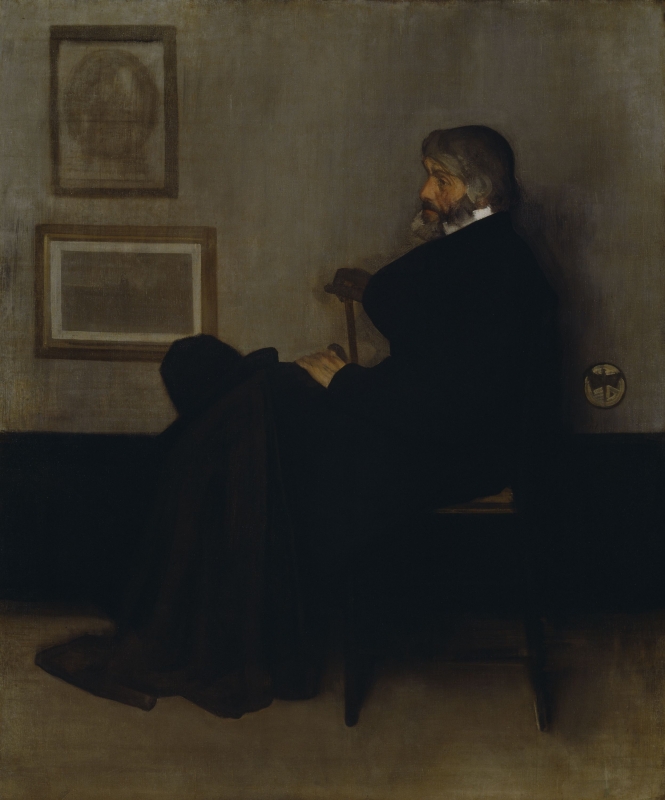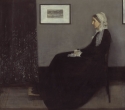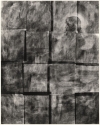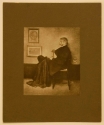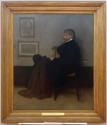Composition
As a formal portrait, this painting follows the portrait of Whistler's mother (Arrangement in Grey and Black: Portrait of the Painter's Mother [YMSM 101]) and shares its essential structure.

Study for 'Arrangement in Grey and Black, No. 2: Portrait of Thomas Carlyle', Art Institute of Chicago
There are several oil sketches related to the finished painting: one, Sketch for the Portrait of Carlyle (1) [YMSM 133], is unlikely to be by Whistler; the next, Sketch for the Portrait of Carlyle (2) [YMSM 134], may be largely by Whistler; then comes a study for the composition, Study for 'Arrangement in Grey and Black, No. 2: Portrait of Thomas Carlyle' [YMSM 135] and finally a vivid Study for the Head of Carlyle [YMSM 136].
An X-ray of the painting shows few alterations except around the head and shoulders. The head was probably moved lower and to the right about 1 cm (½") and reduced slightly in size as the outline was made more precise.
A visual examination suggests that much of the painting has been changed. There is a dark area to the right of the figure where his back has been moved to the left. His left shoulder appears to have been heavily reworked. The breast of Carlyle's coat has been twice changed, and moved to the right. His left hand and hat were originally higher and to the left. His right hand, leaning on the stick, was likewise further to the left, but lower down. His left elbow was lower. The coat may not originally have trailed on the ground, but the fold of the hem on the left was much longer – so that the outline was less broken, and looked more rounded, like a skirt.
A chalk drawing in the Freer Gallery of Art (r.: Portrait sketch of Thomas Carlyle; v.: Head [M.0462]) shows Carlyle in a looser jacket that does not bulge out over his chest; in addition, the chair is more at an angle to the wall and there is no coat over his knees. Interestingly, on the verso is a study of Carlyle's head looking almost directly at the viewer.
In the oil painting, the chair has also been altered, confirming the suggestion of the chalk drawing that it had originally been at more of an angle, for there appear to be the marks of chair legs between the two legs now seen, and to their right. The chair leg at the left also appears to have been originally thicker – 5 cm (2") wide – and to have been curved.
Technique
The head is painted thinly, so that, as George Moore (1852-1933) pointed out, 'it often hardly amounts to more than a glaze, and painting is laid over painting, like skin upon skin.' 1
Carlyle's hair is painted surprisingly broadly, with a 1.2 cm (½") brush. The same brush defines the butterfly and its cartouche neatly. The coat was outlined in black and painted with a broad brush, 3 cm (1 ¼") wide, in so thin a wash that it has dripped in places. The shoulders and collar are painted more thickly than the rest of the painting.
Conservation History
F. Haines & Co., restorers, varnished the portrait for the International Exhibition, Kelvingrove, Glasgow, 1888. 2 It was cleaned and varnished in 1891, and Whistler assured Glasgow Corporation that it was in perfect condition. 3
It was vandalised in 1966, and a scratch across the lower corner was repaired. 4
Frame
1874/1878: the original frame, as exhibited in 1874 and at the Westminster Palace hotel in 1878 was probably similar to that on Harmony in Grey and Green: Miss Cicely Alexander [YMSM 129] and the basket weave incised frame on Symphony in Flesh Colour and Pink: Portrait of Mrs Frances Leyland [YMSM 106]. 5
It went to Glasgow in 1891, according to Whistler, in a frame designed by himself – that is, a Grau frame: 'I have had the picture newly framed in the frame of my own design in which I trust it may always remain', he wrote. 6 The new frame given to Whistler’s portrait of Carlyle did not go unnoticed. In the Pall Mall Gazette, ‘a Correspondent’ wrote that:
'It is in splendid condition and should last as long as paint and canvas may. Mr. Whistler bestows the most loving care upon works of art. He will not again exhibit a picture until a year or more after it has been painted – until it has been varnished, in fact, and entirely completed. The "Carlyle" is in this sense only recently finished. It has lately been varnished, put behind plate glass, and sealed up in one of the artist’s most recently-designed frames.' 7
Notes:
1: Moore 1892 (April, II)[more] , at p. 436. Moore 1893 [more] , p. 18.
2: A. Graves to Whistler, 19 March 1888, GUW #01824.
3: Whistler to G. H. Lewis and Elizabeth Lewis, [29 January 1891], GUW #02550; Whistler to J. W. Paton, 26 March 1891, GUW #01674.
4: Evening Citizen, Glasgow, 18 April 1966.
5: Dr Sarah L. Parkerson Day, Report on frames, 2017; see also Parkerson 2007 [more] .
6: Whistler to J. W. Paton, 26 March 1891, GUW #01674.
7: 'A Correspondent', ‘Mr. Whistler’s Portrait of Carlyle’, Pall Mall Gazette, 9 April 1891; press cutting in GUL Whistler PC 11/39.
Last updated: 8th June 2021 by Margaret

